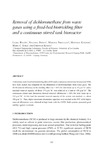Mostrar o rexistro simple do ítem
Removal of dichloromethane from waste gases using a fixed-bed biotrickling filter and a continuous stirred tank bioreactor
| dc.contributor.author | Bailón Allegue, Laura | es_ES |
| dc.contributor.author | Dopico, Yolanda | es_ES |
| dc.contributor.author | Nikolausz, Marcell | es_ES |
| dc.contributor.author | Kästner, Matthias | es_ES |
| dc.contributor.author | Veiga, María Carmen | es_ES |
| dc.contributor.author | Kennes, Christian | es_ES |
| dc.date.accessioned | 2014-10-01T10:17:02Z | |
| dc.date.available | 2014-10-01T10:17:02Z | |
| dc.date.issued | 2007 | es_ES |
| dc.identifier.citation | Biotechniques for Air Pollution Control II, 2007: 505-514. ISBN: 978-84-9749-258-4 | es_ES |
| dc.identifier.isbn | 978-84-9749-258-4 | es_ES |
| dc.identifier.uri | http://hdl.handle.net/2183/12847 | |
| dc.description.abstract | [Abstract] A laboratory scale fixed bed biotrickling filter (BTF) and a continuous stirred tank bioreactor (CSTB) have been studied and compared for the elimination of dichloromethane from waste gases. The DCM removal efficiency in the trickling filter was > 85% for inlet loads up to 25 g.m-3.h-1 and a maximal removal capacity of about 170 g.m-3.h-1 was achieved at a load of 350 g.m-3.h-1. The continuous stirred tank bioreactor showed removal efficiencies > 90% for inlet loads up to 120 g.m-3.h-1. At this load the maximal removal capacity of the system was reached, i.e. about 100 g.m-3.h-1. Thus, higher maximum elimination capacities were reached in the BTF while higher removal efficiencies were obtained at high loads with the CSTB. Both systems presented good stability against overloads. | es_ES |
| dc.language.iso | eng | es_ES |
| dc.publisher | Universidade da Coruña | es_ES |
| dc.title | Removal of dichloromethane from waste gases using a fixed-bed biotrickling filter and a continuous stirred tank bioreactor | es_ES |
| dc.type | conference output | es_ES |
| dc.rights.accessRights | open access | es_ES |
| UDC.coleccion | Publicacións UDC | es_ES |






